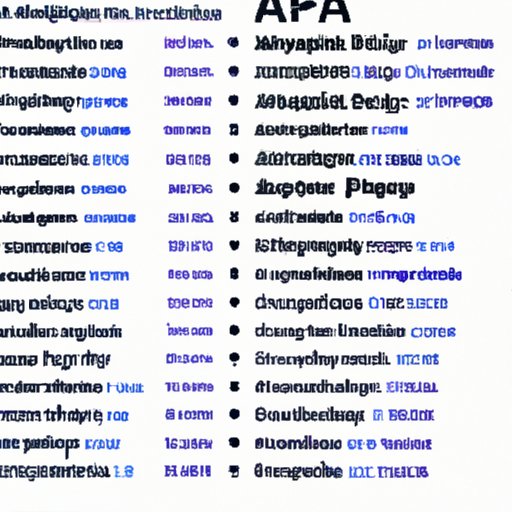Introduction
APA Style is a set of guidelines developed by the American Psychological Association (APA) for formatting and referencing documents in the social sciences. The purpose of APA is to ensure consistency in the presentation of scientific papers, allowing readers to easily locate and verify sources. This article provides an overview of APA style for science writing and explores the benefits, commonly used rules, and tips for formatting scientific writing. Examples of properly formatted scientific writing with APA are also provided.
Overview of APA Style for Science Writing
The sixth edition of the Publication Manual of the American Psychological Association (APA 6) provides guidance on how to format and reference scientific papers. It includes detailed instructions on formatting, citations, references, headings, abbreviations, figures, and tables. In addition, it includes guidelines on the use of language, grammar, punctuation, margins, and other aspects of academic writing.

Benefits of Using APA for Scientific Writing
There are many advantages to using APA for scientific writing. First, it makes it easier for readers to follow the argument being presented. The consistent format and numbering system make it easier for readers to find and verify sources. Second, using APA helps to ensure the accuracy of the content. By following the guidelines, authors can be sure that their research is accurately represented and cited. Finally, APA can help authors save time when formatting their work. By following the guidelines, authors can focus less on formatting and more on content.

Commonly Used Rules in APA for Scientific Writing
When formatting a scientific paper, there are several key rules to follow. These include general formatting guidelines, in-text citations, and reference lists.
General Formatting Guidelines
APA recommends that all scientific papers be double-spaced and have 1 inch margins on all sides. The font size should be 12 point Times New Roman and the line spacing should be set to “double” or “1.5.” The title page should include the title of the paper, the author’s name, and the institutional affiliation. The page header should include the page number on the right side and the title of the paper on the left side.
In-Text Citations
When citing sources in the body of the paper, APA requires the use of in-text citations. These citations should include the author’s last name and year of publication. For example, (Smith, 2020). If the author’s name is not available, the title of the source should be used instead. For example, (“Study on Sleep,” 2020).
Reference List
At the end of the paper, authors should provide a list of all sources cited in the body of the paper. This list should be arranged alphabetically by author’s last name. Each entry should include the author’s last name, first initial, year of publication, title of the source, and the publisher. For example, Smith, J. (2020). Study on Sleep. ABC Publishers.

Tips for Formatting Scientific Writing with APA
In addition to following the basic formatting guidelines, authors should consider the following tips when formatting scientific writing with APA.
Use of Headings
APA recommends the use of headings to organize the content of a scientific paper. Headings should be used to divide the paper into sections and subsections. The headings should be numbered consecutively and should reflect the hierarchical structure of the paper. For example, the first heading should be “1. Introduction” and the second heading should be “2. Literature Review.”
Abbreviations
APA recommends that authors use abbreviations sparingly and only when necessary. All abbreviations should be defined in the text when they are first used. Abbreviations should be spelled out in full followed by the abbreviation in parentheses. For example, Attention Deficit Hyperactivity Disorder (ADHD).
Figures and Tables
APA recommends that authors use figures and tables to present large amounts of data in a concise way. Figures and tables should be labeled consecutively and should include a descriptive title. For example, Figure 1. Average Sleep Duration by Age Group. Authors should also refer to figures and tables in the text and cite them in the reference list.
Examples of Properly Formatted Scientific Writing with APA
To demonstrate how to properly format a scientific paper with APA style, here are three examples: a sample paper, an example of an in-text citation, and an example of a reference list.
Sample Paper
This is an example of a properly formatted scientific paper with APA style. It includes the title page, page header, headings, in-text citations, figures, and reference list. The paper is double-spaced, has 1 inch margins, and is written in 12 point Times New Roman font.
Example of In-Text Citation
An example of an in-text citation in APA style would be: “It has been found that sleep deprivation can lead to cognitive deficits (Smith, 2020).”
Example of Reference List
The reference list for this paper would include: Smith, J. (2020). Study on Sleep. ABC Publishers.
Conclusion
APA style is a widely accepted standard for scientific writing. It provides authors with a consistent format and numbering system which makes it easier for readers to find and verify sources. By following the guidelines, authors can ensure the accuracy of their work and save time when formatting. Examples of properly formatted scientific writing with APA have been provided to demonstrate how to use APA style for scientific writing.
(Note: Is this article not meeting your expectations? Do you have knowledge or insights to share? Unlock new opportunities and expand your reach by joining our authors team. Click Registration to join us and share your expertise with our readers.)
